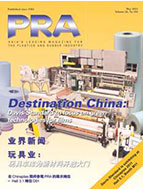 |
 |
E-News Update May 2011 |
LEAD FEATURE |
COMPANY NEWS |
MATERIALS NEWS |
MACHINERY NEWS |
EXHIBITION NEWS |
INJECTION MOULDING ASIA |
PRA May 2011 Electronic Issue Now Available |
![]() Injection Moulding Asia
Injection Moulding Asia
Composites with metallic inserts for automotives
N
ew lightweight automotive carbon fibre-reinforced composites with metallic inserts, said to be 40% lighter and more cost competitive, are being developed by materials supplier Evonik together with industrial partners Johnson Controls, Jacob plastics, Toho Tenax Europe and the University of Aachen (Institute for textile technology) and the Automotive Institute.Creavis, the strategic research and development centre of Evonik, is developing a novel lightweight construction concept where both steel and lightweight metals are to partially replaced. The project is called CAMIMSA (translated from the German: carbon fibre/amide/metal-based interior structural elements in a multi-material system approach).
It is funded by the German Ministry of Education and Research (BMBF) and belongs to the WING call (material innovation for industry and society). The project began early April 2011 and is set to run for three years.
Since lower weight was only realised by adjusting existing systems, such as thinner steel sheets, now new materials and construction designs need to be developed. In this context, fibre-reinforced polymers or composites (FRP), especially those based on carbon fibres, have received wide attention.
Currently employed in the aeronautical sector, this group of materials with their high specific mechanical strength and formation freedom offer the possibility of new lightweight construction concepts. However, for mass production in the automotive sector, they are still too expensive. This essentially lies twofold for FRP: high raw material costs and a very time intensive production. They are yet not competitive against standard sheet metal forming processes.
It is this point in which the CAMISMA project has plans to increase the production cycle rates in order to facilitate the economical mass production. Furthermore, the connection of FRP elements to metal-based frames has yet not been satisfactorily solved, says Evonik. The project will cover a complete solutions approach to allow the entrance of economically priced carbon fibre composites for multi-material systems. To determine the feasibility of this concept, the project team will develop a seat panel structure. The overall goal is to reduce the weight of a standard metallic system by 40%.

